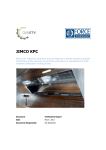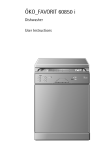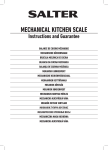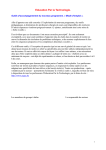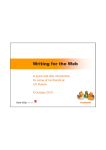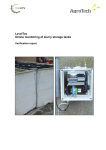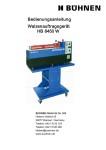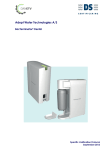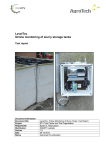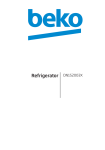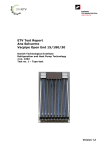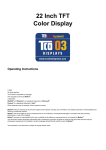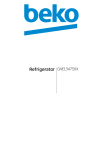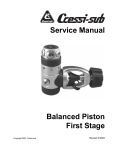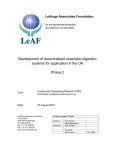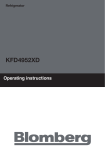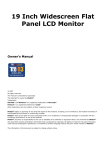Download JIMCO KPC
Transcript
JIMCO KPC Device for reduction of grease and oil deposits in hoods and ducts and for reductions of the emission of particles and odour in ventilation air from commercial kitchen cooking hoods Document Verification Protocol Date November 2012 Document Responsible Ole Schleicher JIMCO Verification Protocol Table of contents 1. 1.1. 1.2. 1.3. 1.4. 1.5. INTRODUCTION ................................................................................................. 4 NAME OF TECHNOLOGY ................................................................................................. 4 NAME AND CONTACT OF PROPOSER .................................................................................. 4 NAME OF VERIFICATION BODY/VERIFICATION RESPONSIBLE .................................................... 4 VERIFICATION ORGANIZATION INCLUDING EXPERTS .............................................................. 4 VERIFICATION PROCESS ................................................................................................ 5 2. OVERALL DESCRIPTION OF TECHNOLOGY GROUP / TECHNOLOGY TYPE ........ 6 3. DESCRIPTION OF THE SPECIFIC TECHNOLOGY FOR VERIFICATION ............... 7 3.1. APPLICATION AND PERFORMANCE PARAMETER DEFINITIONS .................................................... 7 3.1.1. MATRIX/MATRICES........................................................................................................................... 7 3.1.2. PURPOSES ...................................................................................................................................... 7 3.2. PERFORMANCE PARAMETERS FOR VERIFICATION ................................................................... 7 3.2.1. REGULATORY REQUIREMENTS ............................................................................................................. 7 3.2.2. STATE-OF-THE-ART PERFORMANCE ...................................................................................................... 8 3.2.3. SELECTED PERFORMANCE PARAMETERS ................................................................................................ 8 3.2.4. OPERATIONAL PARAMETERS ............................................................................................................... 8 3.3. ADDITIONAL PARAMETERS.............................................................................................. 9 3.3.1. USER MANUAL................................................................................................................................. 9 3.3.2. REQUIRED RESOURCES FOR OPERATION ................................................................................................ 9 3.3.3. OCCUPATIONAL HEALTH AND ENVIRONMENT ....................................................................................... 10 4. 4.1. 4.2. 4.3. 5. 5.1. 5.2. 5.3. 5.4. 5.5. 6. 6.1. 6.2. 6.3. 6.4. EXISTING DATA ............................................................................................... 10 SUMMARY OF EXISTING DATA ........................................................................................ 10 QUALITY OF EXISTING DATA ......................................................................................... 11 ACCEPTED EXISTING DATA ........................................................................................... 11 TEST PLAN REQUIREMENTS............................................................................. 11 TEST DESIGN............................................................................................................ 11 REFERENCE ANALYSIS AND MEASUREMENT ........................................................................ 14 DATA MANAGEMENT ................................................................................................... 14 QUALITY ASSURANCE .................................................................................................. 14 TEST REPORT ........................................................................................................... 14 EVALUATION .................................................................................................... 15 CALCULATION OF PERFORMANCE PARAMETERS ................................................................... 15 EVALUATION OF TEST DATA QUALITY .............................................................................. 15 OPERATIONAL PARAMETER SUMMARY .............................................................................. 15 ADDITIONAL PARAMETER SUMMARY ................................................................................ 15 7. VERIFICATION SCHEDULE ............................................................................... 16 8. QUALITY ASSURANCE ...................................................................................... 16 9. REFERENCES .................................................................................................... 17 2 JIMCO Verification Protocol Appendices A. B. Terms and definition JIMCO KPC-B model 3 JIMCO Verification Protocol 1. INTRODUCTION Environmental technology verification (ETV) is an independent (third party) assessment of the performance of a technology or a product for a specified application, under defined conditions and quality assurance. This document is the protocol to be used for verification of a UV-C 1 technology used in hoods and ducts in ventilation air from commercial kitchen cooking hoods. 1.1. NAME OF TECHNOLOGY The technology to be verified is JIMCO KPC 2. 1.2. NAME AND CONTACT OF PROPOSER JIMCO A/S Ellehaven 4 A DK-5900 Rudkøbing Denmark Contact: Jimmy K. Larsen E-mail: [email protected] Phone: +45 6251 5456 1.3. NAME OF VERIFICATION BODY/VERIFICATION RESPONSIBLE The Danish Centre for Verification of Climate and Environmental Technologies (DANETV), FORCE Technology DANETV, Air and Energy Centre. Verification Test Centre (DANETV) Verification responsible FORCE Technology Park Allé 345 DK-2605 Brøndby Denmark Ole Schleicher E-mail: [email protected] Phone: +45 4326 7540 Cell phone: +45 2269 7540 1.4. VERIFICATION ORGANIZATION INCLUDING EXPERTS The verification will be conducted by the Danish Centre for Verification of Climate and Environmental Technologies, DANETV, which performs independent tests of technologies and products for the reduction of climate changes and pollution. 1 2 UV-C: UV radiations in the C band KPC: Kitchen Pollution Control 4 JIMCO Verification Protocol The verification is planned and conducted to comply with the requirements from the emerging EU ETV pilot program /4/. The day to day operations of the verification and tests will be coordinated and supervised by FORCE Technology personnel, with participation of the proposer. A technical expert group is established to support FORCE Technology in planning, conducting and reporting the verification and tests, and to review plans and reports. The organization chart in Figure 1 identifies the relationships of the organization associated with this verification and tests. Figure 1 Organization of the verification and tests The technical expert assigned to this verification and responsible for review of the test plan and test report documents includes: William Hansen FLSmidth A/S Airtech, Technology Development Ramsingsvej 30, 2500 Valby, Denmark E-mail: [email protected] Phone: +45 3618 1258 1.5. VERIFICATION PROCESS 5 JIMCO Verification Protocol Verification and tests will be conducted in two separate steps, as required by the EU ETV. The steps in the verification are shown in Figure 2. Figure 2 Verification steps References for the verification process are the Centre Quality Manual /1/. A verification statement will be issued after completion of the verification. 2. OVERALL DESCRIPTION OF TECHNOLOGY GROUP / TECHNOLOGY TYPE The technology to be verified is based on the effect from ultraviolet radiation in the C band (UV-C), which covers the wavelength range of 10 - 280 nm. The UV-C radiation has a strong germicidal effect on fungi, bacteria and viruses, and the technology is widely used in hospitals, health care facilities, and food processing plants, shelters, prisons and other commercial uses, where elimination of biological activity is important. The effect of UV radiation is commonly known from sunburns, which is caused by the UV radiation in sunlight. It is evident, that UV radiation has a strong effect on organic matter. The UV-C radiation is produced in special fluorescent tubes made from quartz glass, which is optimized to give the strongest germicidal effect by emitting radiation at 253.7 nm, and also radiation at 185 nm, which produces ozone from the oxygen around the tubes. The UV radiation at 253.7 nm will attack and break down the organic compounds close to the tubes, and the produced ozone can do the same, but the effect will continue throughout the exhaust system, until all the ozone has reacted, or the air is emitted to the ambient air. 6 JIMCO Verification Protocol The double bonds in the grease and oil molecules are most likely broken down first, as the double bonds are more reactive then the single bonds. This results in large molecules being broken down into smaller and smaller molecules. Organic deposits (oil and grease) in the hoods and throughout the whole ventilations system is also attacked by the ozone, and the deposits is claimed to be reduced over a period of time due to ultraviolet photo catalytic oxidation and destruction of the organic deposits. 3. DESCRIPTION OF THE SPECIFIC TECHNOLOGY FOR VERIFICATION 3.1. APPLICATION AND PERFORMANCE PARAMETER DEFINITIONS The JIMCO KPC utilizes the UV-C technology (UV radiations in the C band). The fluorescent tubes are the germicidal and ozone type, which means, that they emit the germicidal radiation at 253.7 nm and the ozone producing radiation at 185 nm. See Appendix B for specific information, pictures and drawings for the KPC technology. To achieve the best effect, the KPC units are preferably mounted in the hoods just behind the grease filter. The UV radiation effect from the fluorescent tubes will decrease over time, depending on the quality, the environment and how often they are turned on and off. The tubes provided from the proposer will still have 85 % of the original UV radiation after 10 000 hours of operation. 3.1.1. Matrix/matrices Ventilation air from commercial kitchen cooking hoods. 3.1.2. Purposes Reduction of grease and oil deposits in ducts and emission of particles and odour. 3.2. 3.2.1. PERFORMANCE PARAMETERS FOR VERIFICATION Regulatory requirements No direct regulatory requirements for kitchen hood exhaust emissions are known by the Verification Test Centre or by the proposer. Indirect regulations for odour nuisances are common in Denmark, and most likely in many other countries, and some countries have strict regulations for deposits in ventilations systems. Several commercial kitchens are situated in cities with short distances from the cooking hood exhaust to neighbours and trespassing people, where odour nuisances can be a major issue, and consequently many kitchens have to either install odour abatement systems, or emit the exhaust air above the roof, which can be on top of a house with many floors. 7 JIMCO Verification Protocol Some countries have regulations demanding ducts in exhaust systems to be kept clean, e.g. to reduce fire risk, which are most relevant for ducts from kitchen cooking hoods, where deposits of oil and grease are especially fire risky. According to information from the proposer, the chimney sweepers in Germany are also responsible for controlling and cleaning exhaust system, and consequently they will be inspected and cleaned regularly. UK has a “Guidance on the Control of Odour and Noise from Commercial Kitchen Exhaust Systems” to help the local authorities to control set up permits and demands for such facilities. Regarding deposits the Guidance recommend regular cleaning of the exhaust system, depending on the daily operational time. The recommended cleaning period is: • • • 3.2.2. Every 3 month for heavy use, which is 12-16 hours per day Every 6 month for moderate use, which is 6-12 hours per day Annually for light use, which is 2-6 hours per day State-of-the-art performance There is no State-of-the-art performance for this technology. 3.2.3. Selected performance parameters According to the proposer’s request, the following three performance parameters have been selected: 1. Oil and grease deposits in hoods and ducts. 2. Emission of odour. 3. Emission of particles measured as oil mist. The parameters no. 1 and 2 are equally important, as they are important issues for many commercial kitchens. The third parameter is less important for the proposer and for the users of the technology. However, if the concentration of oil mist can act as an indicator for the potential deposition of grease and oil during the test, it could be important in that respect. 3.2.4. Operational parameters The temperature around the UV tubes must not exceed 50 °C, because the effect from UV radiation decreases with increasing temperature. Normally the temperature in commercial kitchen hoods are below this limit, otherwise the air flow should be increased to lower the temperature. The air velocity around the UV lamps is specified by the proposer, to achieve a sufficient retention time for the UV radiations to break bonds in the grease and oil molecules. The air retention time in the ventilation system shall be at least 2-4 seconds, to let the ozone react before emission and dilution in the ambient air. 8 JIMCO Verification Protocol The activity in the kitchen during the test shall be documented by the sale on a 15 minutes basis, which can be supplied from the kitchen. 3.3. 3.3.1. ADDITIONAL PARAMETERS User manual The user manual and installation guide for the KPC is currently being revised by the proposer, and the present version has been evaluated in Table 1. Table 1 User Manual Parameter Product Principle of operation Intended use Performance expected Limitations Unpacking Transport Assembly Installation Function test Steps of operation Points of caution Maintenance Trouble shooting Complete description Incomplete description No description Not relevant X X X X X X X X X X X X X General instructions Power and high voltage X X The proposer strongly recommends clean hoods and ducts before installing KPC, but this is very weakly described in the manuals. It is recommended to highlight this recommendation in the manuals, and clearly explain why it is so important for the performance of the KPC. 3.3.2. Required resources for operation The required resources for operation are only electricity for the UV lamps, some manpower for regularly cleaning of the UV lamps and cost for replacement of the UV lamps after 10 000 hours of operation. The UV-C lamps have to be cleaned regularly to maintain their efficiency. A frequency of once a week is often enough, but depending of the load of oil and grease mist, a higher or lower frequency must or can be applied. Cleaning is normally done together with cleaning the grease filters in front of the UV-C lamps. 9 JIMCO Verification Protocol 3.3.3. Occupational health and environment The UV-C light is harmful for the eyes, and looking directly at the light shall be avoided. Consequently the units shall automatically be turned off, when removing the grease filters in front of the KPC. The UV-C produces ozone, and to avoid entry of ozone into the kitchen, the KPC can and must only run when the ventilations system is on. The UV-C lamps will automatically be turned off by a pressure sensor, if the extraction is lost. 4. EXISTING DATA 4.1. SUMMARY OF EXISTING DATA The effect of the technology claimed by proposer is based on the proposers experience with the technology since 1995, and from several investigations where the reducing effect on different parameters has been measured and reported by an independent party. The effect on reducing oil and grease deposits are only based on the proposers experience, which is documented by pictures of hoods and ducts before and some time after the installation of KPC, showing clean surfaces and/or decreasing depositions. Reports on KPC performance from Analytical Laboratories PTE LTD.: • • • Oil mist (as toluene) assessment for BBQ and tandoori cooking hoods inlet and outlet of JIMCO UVC-Ozone air treatment system at Tanglin Club. May 2012 Report No. AC/ES/3696/12. Oil mist (as odour) assessment for cooker hood exhaust inlet (before) and outlet (after) of genmech JIMCO UV filtration system. July 2008. Report No. AC/ES/4622/08. Source emission monitoring for domestic cooker hood. May 2002. Report No. AC/ES/3710/02. Some additional reports on the performance of the technology have been provided by the proposer, but they are from industrial installations, which are different and not directly comparable to the KPC units. Report for the Periodic Monitoring of Emissions to Air. Permit No.: NP3333UU/V003, Birds Eye, Lowestoft, Jul-11. Industrial plant for deep frying (chicken), equipped with a JIMCO UVC emission control. Three odour measurements taken simultaneously from before and after the UV-C unit, documents a 96 – 97 % reduction. A 65 % to 86 % odour reduction was measured on an industrial plant for deep frying fish equipped with JIMCO UV-C units for odour reduction. The odour reduction from installing a JIMCO KPC in a McDonalds restaurant was measured and calculated to be 93 % by the proposer, but the measurements before and after was not 10 JIMCO Verification Protocol simultaneous, and the conditions for the measurements with and without the KPC was too different to justify a calculation of the reduction. It is considered, that the ability to reduce odour by JIMCO KPC technology has been documented by the supporting documents, but the efficiency has not been sufficiently documented. 4.2. QUALITY OF EXISTING DATA The quality of the existing data valid directly for the JIMCO KPC system is poor and cannot be used for the verification, but only to support the assumed performance claimed by the proposer. Some of the data for the industrial use of the JIMCO UV-C technology are high quality and reliable data, but as they are not valid for the KPC, they can also only support the assumed performance claimed by the proposer, even though they seem to document the odour reducing effect of the technology. 4.3. ACCEPTED EXISTING DATA None of the existing data can be used directly for the verification. Some of the data documents a possible effect of the technology, but the test condition and measurement methods has not been adequate, and cannot support unambiguous conclusions about the performance. 5. TEST PLAN REQUIREMENTS The test must include measurements of the odour concentration and the concentration of particles/oil mist before and after the UV-C treatment, but as the KPC units are mounted in kitchen hoods, it is not possible to take representative samples before the units. Instead the measurements must be conducted with a series of samples with the UV-C units alternately on and off. As the productions in the kitchen vary over the day, with a normal maximum around 12 AM to 2 PM and again from 6 PM to 8 PM, a number of samples must be drawn in these periods. The production may vary even between an on-period and an off-period, and a sufficient number of pairs are necessary to obtain a statistically valid result. A sufficient number cannot be defined for sure on beforehand, but nine pairs are considered necessary and sufficient. In case, the variations between results in off-periods are very large, more samples must be drawn – depending on statistical validity desired. 5.1. TEST DESIGN The JIMCO KPC is tested on an installation in a commercial kitchen. The kitchen has two deep fry stations beside each other in the left side of the kitchen, the first is used for French fries and the second for fish and chicken. On the right side there is a 11 JIMCO Verification Protocol griddle for meat. Each of these three places has its own hood, where the KPC can be mounted. On the roof the ducts from the three hoods are connected to one common duct before the fan and the exhaust pipe. The air flow from the three hoods can be adjusted by valves. Preliminary odour measurements have shown relatively high concentrations in the exhaust system, without any activity in the kitchen (background odour level), which is attributable to depositions of grease and oil in the hoods and ducts (rancidification and possible biological degradations of oil and grease deposits creates malodour). These concentrations are significant compared to the normal odour concentration from normal activities in the kitchen. Consequently the hoods and ducts must be thoroughly cleaned and/or ducts must be replaced with new and clean ones, to achieve the lowest possible background odour concentration. Otherwise it will not be possible to evaluate the effect from the KPC. Clean ducts are also essential for the evaluation of deposits of grease and oil. The proposer needs a reaction time of at least 2-4 seconds for the ozone reaction to take place, and this is normally achieved before the exhaust point. The fan, which normally is situated on the roof, is anticipated to be impossible to clean sufficiently to achieve the necessary low background odour concentration, and consequently the test must be conducted by measuring odour before the fan. To achieve the necessary retention time of 2-4 seconds, the ducts before the fan must be extended, and some bending must be introduced. The test is divided in two parts: Part one is a pre-test to determine the exact test conditions and part two: Main test – test of performance parameters. Pre-test The pre-test is performed to evaluate the performance of the KPC regarding reduction of the odour concentration taking the back ground odour into consideration. The pre-test shall be conducted in the kitchen busy period, e.g. between 6 PM and 8 PM, and consist of at least four samples with the KPC alternating on and off. Flow and temperature are measured manually before and after the sampling, and ozone is measured in the duct when sampling samples with the UV turned on. Samples for back ground odour level during production time (“warm” back ground) is drawn shortly after kitchen closure. Samples for back ground odour level outside production time (“cold” back ground) is drawn the following morning before start of activities in the kitchen. The pre-test will also include the parameter TOC to get indications of the variations according to activities in the kitchen (and the odour), and if it is affected by the KPC, and thereby define if it as a relevant parameter for the test. The relevancy could either be a correlation to the kitchen activities, to the odour concentration or to a reduction by the KPC. Main test: The verification test is conducted as the pre-test, but the number of odour samples shall be at least 9 pair in total, and consequently the sampling is conducted over two or three days (or evenings). 12 JIMCO Verification Protocol The odour back ground concentration is measured once a week for another four weeks, to verify if the KPC avoids an increasing level. After this period the KPC is turned off, and operated for another four weeks where the back ground concentration are evaluated by weekly measurements. Additionally the emission of oil mist is measured in the chimney after the fan by sampling alternating on two filters, one with the KPC on and one with the KPC off. It is anticipated to be necessary to sample for at least one hour for each filter, to sample enough oil mist to quantify it. Oil and grease deposits will first of all occur in bending where the air changes direction and two inspection doors shall be mounted in these places, one where the deposits are expected, and one on the opposite side of the duct, from where the deposits can be seen. The degree of oil and grease deposits is evaluated by visual inspection once a week, in a four week period after the test. After this period the KPC is turned off, and operated for another four weeks where the deposits are evaluated at least by weekly inspections. The inspection doors shall be replaced by new and clean ones after each of the four week periods, and the amount of deposits is measured. The amount of deposits is quantified by weighing the inspection doors before and after cleaning them with a low boiling solvent, e.g. acetone. The solvent are collected and filtered if any particles are present. Particles are quantified by weighing the filters and the oil and grease are quantified by weighing the residue after low temperature evaporation of the solvent. 13 JIMCO Verification Protocol 5.2. REFERENCE ANALYSIS AND MEASUREMENT Parameter Odour Unit OU/m³ Oil mist mg/m³ Deposits of grease and oil mg/m² Deposits of grease and oil Evaluation TOC (Total Organic Carbon) ppm Ozone Temperature ppm °C Relative Humidity Flow RH % m³/h 5.3. Method Sampling in nalophan bags and analysis by means of dilution equipment Olfactometry Collection on filters. Weighing or analysing by means of gas chromatography. Weighing inspections doors and/or residual from washing inspections doors with solvent. Visual inspection, description and fotos of the deposits Automatic measuring system with FID detection Indicator tubes PT100-thermocouple or a NiCr/NiAl-thermocouple connected to a digital thermometer or datalogger Termo hygrometer Vane anemometer or thermal anemometer. Reference EPA-guideline MEL13 DS/EN 13.725 EPA guideline MEL02, VDI 2066 bl. 1 EPA MEL-1, USEPA method 0010 No references. No references. EN 12619, EN 13526, VDI 3481 bl.3 Dräger VDI 3511 bl. 1-5, IEC 584-2, IEC 5842 amd. 1 ISO 10780 DATA MANAGEMENT Data storage, transfer and control must be done in accordance with the requirements described in the Centre Quality Manual /1/. 5.4. QUALITY ASSURANCE The quality assurance of the tests must include control of the reference system, control of the test system and control of the data quality and integrity. The test plan and the test report will be subject to review by the technical expert as part of the review of this verification protocol and the verification report, see Figure 2. 5.5. TEST REPORT The test report must follow the template in the Centre Quality Manual /1/. 14 JIMCO Verification Protocol 6. EVALUATION The evaluation includes calculation of the performance parameters, evaluation of the data quality based upon the test quality assurance, and compilation of the additional parameters. 6.1. CALCULATION OF PERFORMANCE PARAMETERS Calculations are done according to generally accepted mathematical and statistical principles such as those described in the standards behind the FORCE Technology’s accreditation for emission sampling and analysis /2/ and /3/. 6.2. EVALUATION OF TEST DATA QUALITY The information of the test plan and the test system together with data quality and integrity control will be evaluated against the requirements set in this protocol and the objectives set in the test plan. 6.3. OPERATIONAL PARAMETER SUMMARY The temperature around the UV tubes must not exceed 40 °C, and the air velocity must not exceed 1 m/s when passing the UV lamps. The air retention time in the ventilation system shall be at least 2-4 seconds, to let the ozone react before emission and dilution in the ambient air. The activity in the kitchen during the test shall be documented by the sale on a 15 minutes basis, which can be supplied from the kitchen. 6.4. ADDITIONAL PARAMETER SUMMARY The user manual is currently being revised by the proposer. It is recommended to highlight the recommendation of cleaning hoods and ducts before installing KPC, and to clearly explain why it is sp important for the performance of the KPC. The UV lamps will slowly lose their efficiency, and it is recommended to replace them after 8,000 hours of operation. The lamps also have to be cleaned regularly for grease and oil deposits, at least once a week, to maintain their efficiency. The UV-C light is harmful for the eyes, and consequently the KPC units shall automatically be turned off, when removing the grease filters in front of the KPC. The UV-C produces ozone, and to avoid entry of ozone into the kitchen, the KPC will automatically be turned off by a pressure sensor, if the extraction is lost. 15 JIMCO Verification Protocol 7. VERIFICATION SCHEDULE The overall schedule for the verification is given in Table 2. Table 2 Verification schedule 2012/13. Task Application definition document Verification protocol Test plan Pre-test Test Test report Verification report Verification statement 8. Timing [week no.] QA Expert - - - 40 42 42 – 45 47 - 50 48 02 08 41 44 - 42 05 - 51 04 09 QUALITY ASSURANCE The quality assurance of the verification is described in Table 3 and Figure 2, and the quality assurance of the tests in the test plan. Table 3 QA plan for the verification Internal QA Task Name Technical Expert Knud Christiansen William Hansen Verification Protocol Review Review Test plan Review - Test system at test site Test system and performance audit - Test report Review - Verification Report Review Review Statement of Verification Review - 16 JIMCO Verification Protocol 9. REFERENCES /1/ ETV Test Centre and Test Organisation. Centre Quality Manual – Air and Energy Technology. FORCE Technology Document version 3. March 2012. /2/ FORCE Technology DANAK accreditation no. 51. Accreditation to testing Environmental samples: Air, water, soil, waste. Etc. /3/ FORCE Technology DANAK accreditation no. 65. Accreditation to analyse Environmental samples: Air, water, soil, waste. Etc. /4/ European Commission. EU Environmental Technology Verification pilot program. General Verification Protocol. 20-6-2011 17 JIMCO Verification Protocol Appendix A Terms and definition Effect The way the target is affected ETV Environmental technology verification (ETV) is an independent (third party) assessment of the performance of a technology or a product for a specified application, under defined conditions and adequate quality assurance. Evaluation Evaluation of test data for a technology product for performance and data quality Matrix The type of material that the product is intended for Method Generic document that provides rules, guidelines or characteristics for tests or analysis Performance claim The effects foreseen by the vendor on the target(s) in the matrix of intended use Performance parameters Parameters that can be documented quantitatively in tests and that provide the relevant information on the performance QA Quality assurance Standard Generic document established by consensus and approved by a recognized standardization body that provides rules, guidelines or characteristics for tests or analysis Target The property that is affected by the product Test/testing Determination of the performance of a product for parameters defined for the application Verification Evaluation of product performance parameters for a specified application under defined conditions and adequate quality assurance 18 JIMCO KPC – B Model S W NE Frame incl. ballast Using patented UV-C & Ozone technology JIMCO KPC A/S specialises in odour and grease control CLEANER DUCTING, MINIMISES RISK OF FIRE WHEN COOKING - the exhaust fan will operate more efficiently… MINIMISE RISK OF FIRE !! - if our luck runs out… The KPC-system for odour and grease control uses special lamps that produce UV- light and ozone. The JIMCO lamps are placed in a steel frame, which is installed behind the grease filters in the hood or, in case where this is not possible due to lack of space, in an enclosure immediately above the hood. Exposure to intensive UV-C light and ozone oxidation causes contaminants in the air to be destroyed, resulting in the reduction of odour emissions to the surroundings and no grease deposits in the ductwork. This process reduces the odour emitted to the surroundings. At the same time a small quantity of excess of ozone is generated to maintain the ducts in a clean condition and to destroy previously existing grease deposits within the ductwork. We recommend that ducts be manually cleaned before installing a KPC-B system. The advantages of using a JIMCO KPC system means the traditional problems with air filtration are eliminated. Examples are: high chimneys, electrostatic filters, activated carbon filters, scrubbers, deodorizing oils etc. JIMCO A/S is receiver of the EU Environmental Award 1999-2000 for Cleaner Technology The KPC-B insert consists of a steel frame in 2 different lengths, containing 4 to 8 JIMCO lamps The UV-C lamps have a lifetime of approx. 10.000 operating hours, after which they must be replaced to ensure continued efficiency. Additional advantages: 9 Decreases risk of fire 9 S W NE 9 Maximum exhaust due to clean ductwork Tested and dependable equipment 9 Compact installation, needs only limited space 9 Reduces odour to the surroundings 9 Immediate on/off function 9 No use of chemicals or deodorizing oils 9 Pressure differential guards for fan failure 9 No use of filters, e.g. active carbon or catalysts 9 Competitive installation costs 9 No use of microbiology 9 Low operating and maintenance costs 9 No residues or liquid substances 9 Option: heat reuse 9 Eliminates the need to regularly clean the hood and the kitchen exhaust ductwork 9 Simple to install in existing hoods Additional references available at: JIMCO KPC A/S - Ellehaven 4D - DK- 5900 Rudkoebing Phone: +45 6251 5462 / Fax: +45 6251 5463 E-mail: [email protected] - Website: www.jimco.dk Please call us for additional information – we shall be pleased to assist you!




















